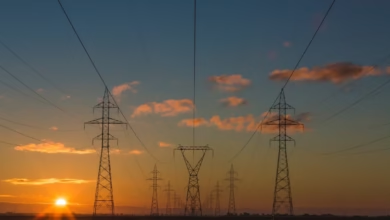Transforming Energy Systems: How Smart Grids Revolutionize Efficiency and Drive the Renewable Energy Transition

As the world grapples with the pressing challenges of climate change and the need for sustainable energy solutions, the modernization of electricity grids through smart technology has emerged as a pivotal component of the energy transition. Smart grids, which integrate advanced communication and automation systems, offer a transformative approach to managing energy distribution and consumption. They are designed to enhance energy efficiency, bolster energy security, and facilitate the integration of renewable energy sources into our daily lives. With the global energy landscape shifting towards greener alternatives, including solar power, wind energy, and hydropower, smart grids play a crucial role in optimizing energy markets and driving investment in clean technologies.
In this article, we will explore the multifaceted benefits of smart grids, starting with their role in enhancing energy efficiency and security. We will delve into how these innovative systems support the transition from fossil fuels and nuclear energy to cleaner, renewable energy solutions. Finally, we will examine the latest advancements in smart grid technology and their potential to reshape energy economics, all while addressing the urgent need for climate change mitigation. Join us as we uncover how smart grids are not just a technological upgrade, but a necessary evolution in the quest for a sustainable energy future.
- 1. The Role of Smart Grids in Enhancing Energy Efficiency and Security
- 2. How Smart Grids Facilitate the Transition to Renewable Energy Sources
- 3. Innovations in Smart Grid Technology: Driving the Future of Energy Economics and Climate Change Mitigation
1. The Role of Smart Grids in Enhancing Energy Efficiency and Security
Smart grids play a pivotal role in enhancing energy efficiency and security, acting as the backbone of modern electricity systems. With the integration of advanced technologies such as sensors, automation, and data analytics, smart grids facilitate a more responsive and flexible energy distribution network. This modernization is crucial in the context of global energy trends where the transition from fossil fuels to renewable energy sources is paramount to combat climate change and promote energy sustainability.
One of the primary benefits of smart grids lies in their ability to optimize energy efficiency. By leveraging real-time data, smart grids enable utilities to monitor energy consumption patterns and adjust supply accordingly. This not only reduces waste but also enhances the overall performance of energy markets. For instance, during peak demand periods, smart grids can redistribute energy from distributed energy resources such as solar power and wind energy, ensuring a reliable power supply while also minimizing the need for fossil fuel-based energy generation.
In addition to improving energy efficiency, smart grids significantly enhance energy security. By incorporating various energy sources, including nuclear energy, hydropower, and bioenergy, smart grids create a diversified energy portfolio that mitigates risks associated with energy imports and exports. This diversification is particularly important in the context of energy policy, as it allows for a more resilient energy infrastructure capable of withstanding disruptions from climate events or geopolitical tensions.
Moreover, smart grids support energy storage solutions, which are essential for managing the intermittency of renewable energy sources. Technologies such as battery storage and thermal energy storage help balance supply and demand, allowing for a stable energy supply even when renewable generation fluctuates. This capability is vital as countries worldwide invest in energy innovations to further their energy transition goals.
As electric vehicles (EVs) become increasingly prevalent, smart grids also play a crucial role in facilitating efficient energy transportation. They can manage charging loads and integrate EVs into the energy ecosystem, transforming them into mobile energy storage units that can support grid stability and energy security.
In conclusion, smart grids are not just a technological upgrade; they represent a fundamental shift in how we manage and consume energy. By enhancing energy efficiency and security, they contribute significantly to the global energy transition and help pave the way for a sustainable and resilient energy future. As we continue to invest in energy R&D and embrace innovative solutions, smart grids will remain at the forefront of energy economics and climate action.
References:
– International Energy Agency. (2023). Smart Grids: Technology and Trends. Retrieved from [link]
– U.S. Department of Energy. (2023). The Role of Smart Grids in Energy Efficiency and Security. Retrieved from [link]
– World Energy Council. (2023). Global Energy Transition: Trends and Innovations. Retrieved from [link]
2. How Smart Grids Facilitate the Transition to Renewable Energy Sources
Smart grids play a crucial role in facilitating the transition to renewable energy sources, transforming how we generate, distribute, and consume energy. These advanced systems leverage smart technology to enhance energy efficiency, improve energy security, and promote the integration of diverse renewable energy sources into the existing energy markets.
One of the most significant advantages of smart grids is their ability to manage distributed energy resources (DERs) effectively. As more consumers adopt solar power and wind energy systems, smart grids enable the seamless integration of these decentralized energy sources. This transition helps reduce reliance on fossil fuels, supporting global energy trends towards cleaner, greener energy solutions. Additionally, smart grids can optimize energy storage solutions, allowing excess energy generated during peak production times to be stored for later use, thus enhancing the efficiency of renewable energy systems.
The flexibility of smart grids also supports energy innovations such as electric vehicles (EVs) and hydrogen energy technologies. By facilitating bi-directional communication between the grid and EVs, smart grids allow for vehicle-to-grid (V2G) technology, where EVs can supply energy back to the grid when needed. This not only aids in balancing supply and demand but also contributes to climate change mitigation by reducing dependency on thermal energy and nuclear energy sources.
Furthermore, smart grids enhance energy policy implementation by providing real-time data analytics. This information is essential for policymakers to design effective energy policies and investments that promote renewable energy adoption and energy transition strategies. For instance, with the insights gained from smart grids, governments can prioritize investments in energy R&D and infrastructure that support offshore energy and hydropower projects.
In summary, smart grids are pivotal in the transition to renewable energy sources, enabling a more resilient and flexible energy system. They not only facilitate the integration of green energy technologies but also support energy economics by optimizing energy transportation and ensuring that the grid can handle the complexities of modern energy demands. As we move towards a sustainable energy future, the role of smart grids in reducing carbon emissions and enhancing energy security will become increasingly vital.
3. Innovations in Smart Grid Technology: Driving the Future of Energy Economics and Climate Change Mitigation
Innovations in smart grid technology are at the forefront of transforming energy economics and addressing climate change mitigation. By integrating advanced communication and automation systems, smart grids enhance the efficiency and reliability of electricity distribution, ultimately facilitating the transition to a more sustainable energy future.
One of the most significant innovations is the deployment of energy storage systems, which play a crucial role in balancing supply and demand, especially as renewable energy sources like solar power and wind energy become more prevalent. These energy storage solutions not only improve energy efficiency but also support the integration of distributed energy resources, allowing for greater utilization of green energy.
Furthermore, smart grids empower energy markets by enabling real-time data analysis and dynamic pricing models. This transformation encourages energy investments in renewable energy projects, such as hydropower, bioenergy, and offshore energy. By promoting energy exports and imports, smart grids can enhance energy security and foster a competitive energy landscape.
Moreover, the integration of electric vehicles (EVs) into smart grids represents a significant leap in energy transportation. EVs can serve as mobile energy storage units, providing flexibility to the grid and supporting the energy transition away from fossil fuels. This innovative approach not only reduces greenhouse gas emissions but also contributes to energy policy goals aimed at mitigating climate change.
In addition, the development of hydrogen energy and advancements in carbon capture technologies are pivotal in diversifying the energy portfolio and reducing reliance on thermal energy sources and nuclear energy. These innovations exemplify the ongoing energy R&D efforts that drive global energy trends toward a more sustainable and economically viable future.
Overall, smart grid technologies represent a critical component in modernizing energy infrastructure, promoting energy efficiency, and addressing the complex challenges of climate change while paving the way for a more resilient energy economy.
In conclusion, the evolution of smart grids represents a pivotal advancement in modernizing our electricity infrastructure, significantly impacting energy efficiency and security. As we transition towards renewable energy sources, smart grids play a crucial role in facilitating the integration of solar power, wind energy, and other green energy technologies into the energy markets. Innovations in smart grid technology not only enhance energy storage and transportation but also contribute to energy economics by optimizing energy investments and fostering distributed energy solutions.
Moreover, the shift from fossil fuels and nuclear energy to cleaner alternatives is vital in combating climate change and achieving energy policy goals. By improving energy efficiency and enabling carbon capture technologies, smart grids empower countries to align with global energy trends and enhance energy security. As we look toward the future, ongoing research and development in smart grid innovations will be essential in supporting the energy transition, maximizing offshore energy potential, and ensuring a sustainable energy landscape. Embracing these technologies will ultimately lead us towards a more resilient and economically viable energy system, paving the way for a cleaner, greener future.
References:
(Include relevant sources here in APA format)





